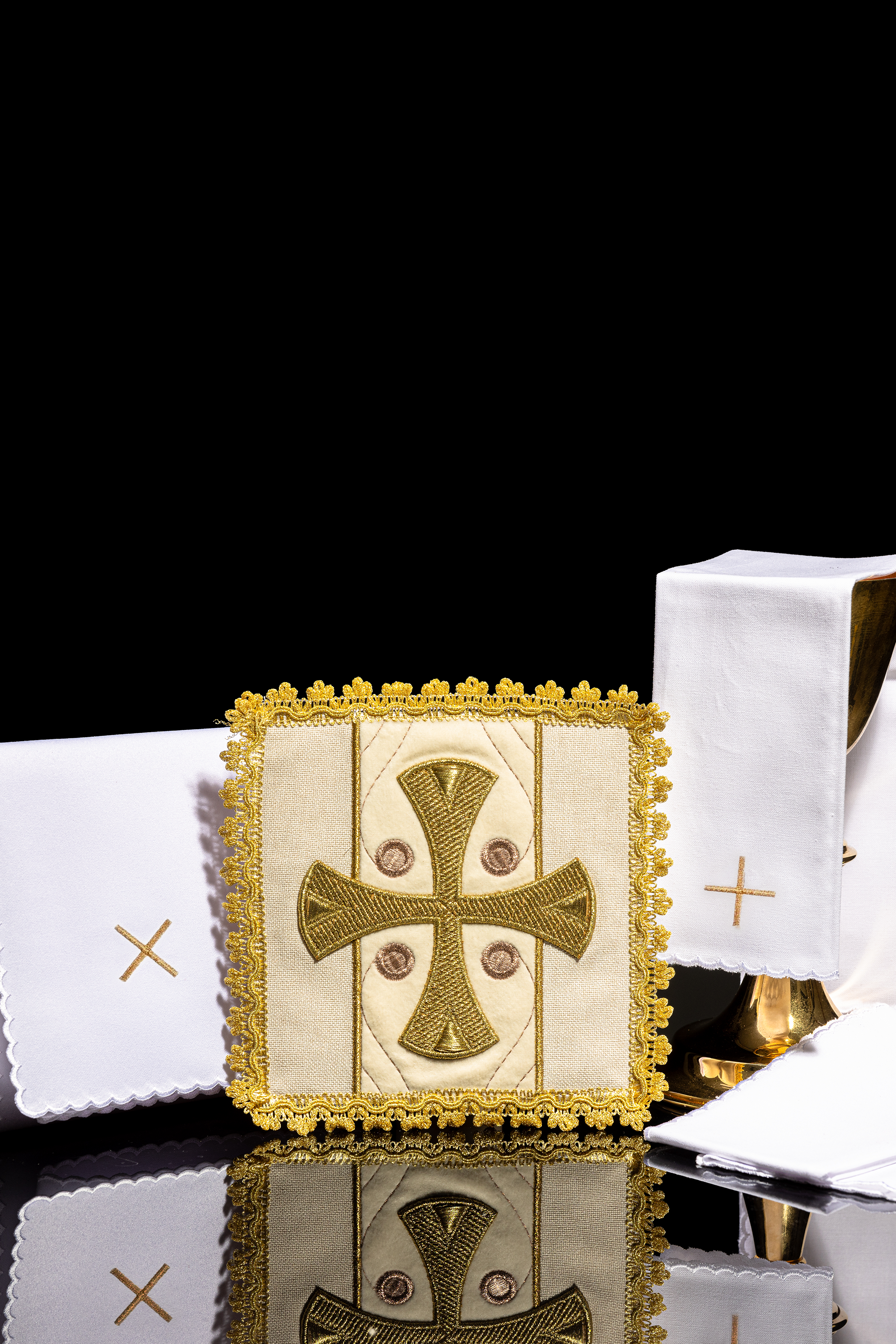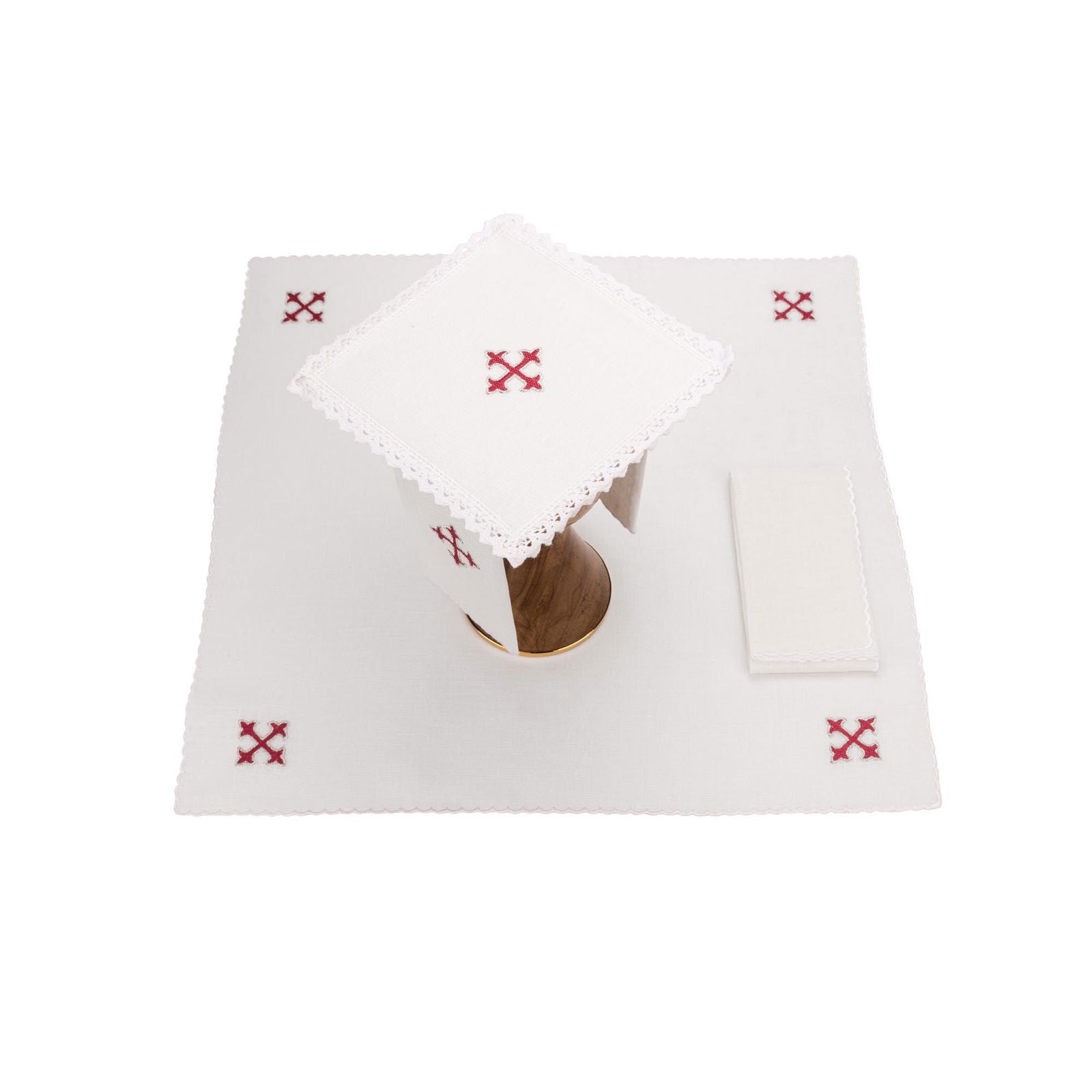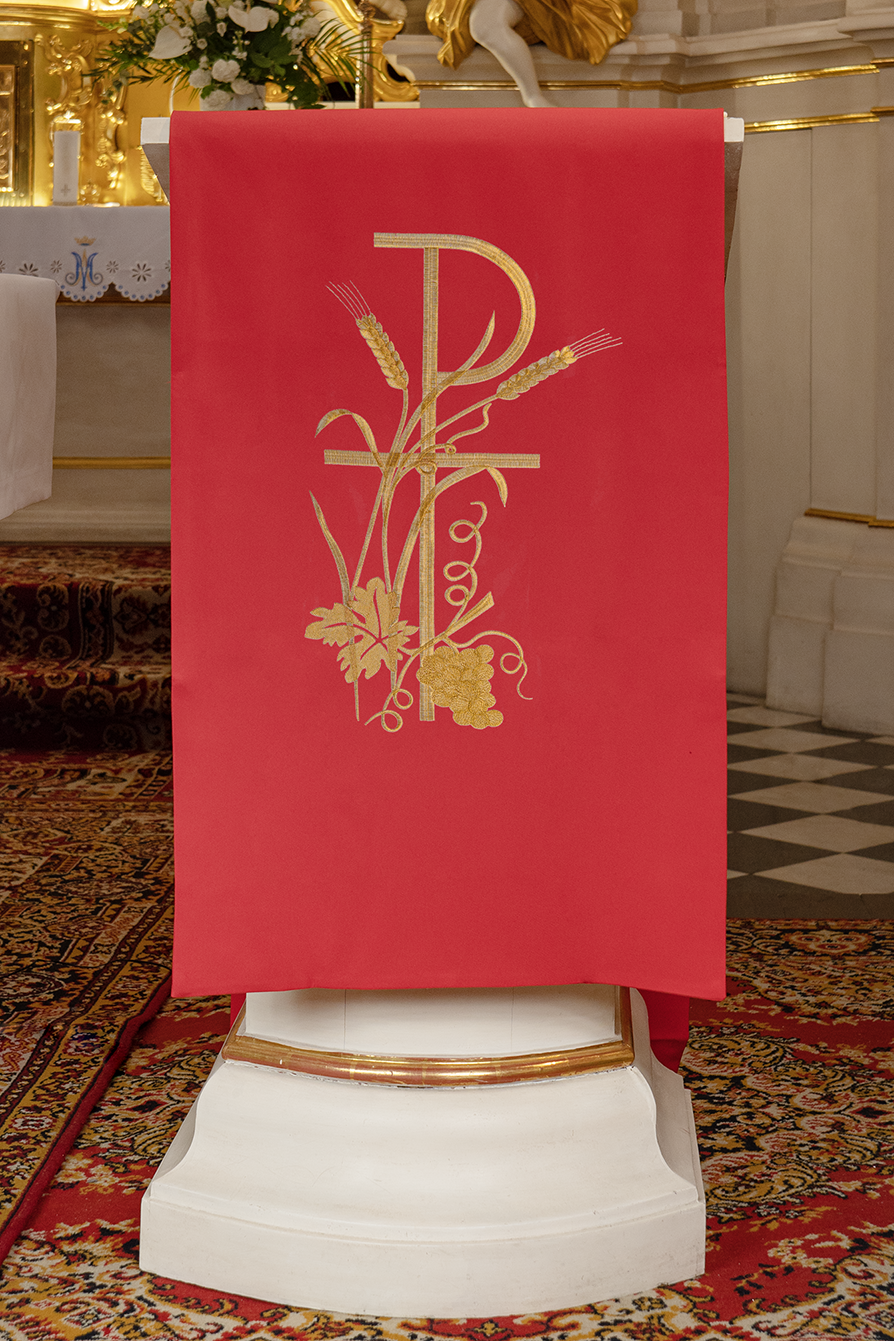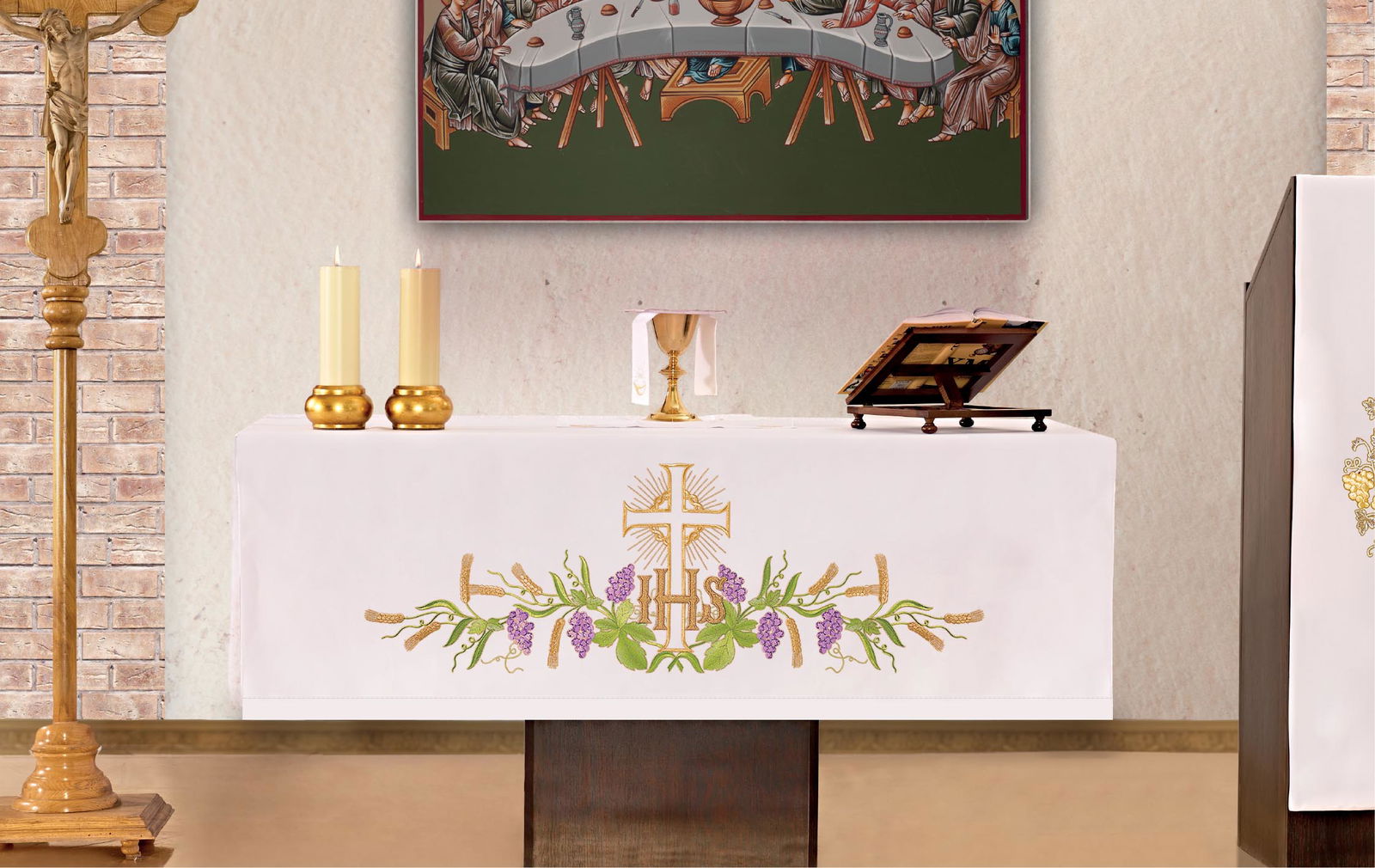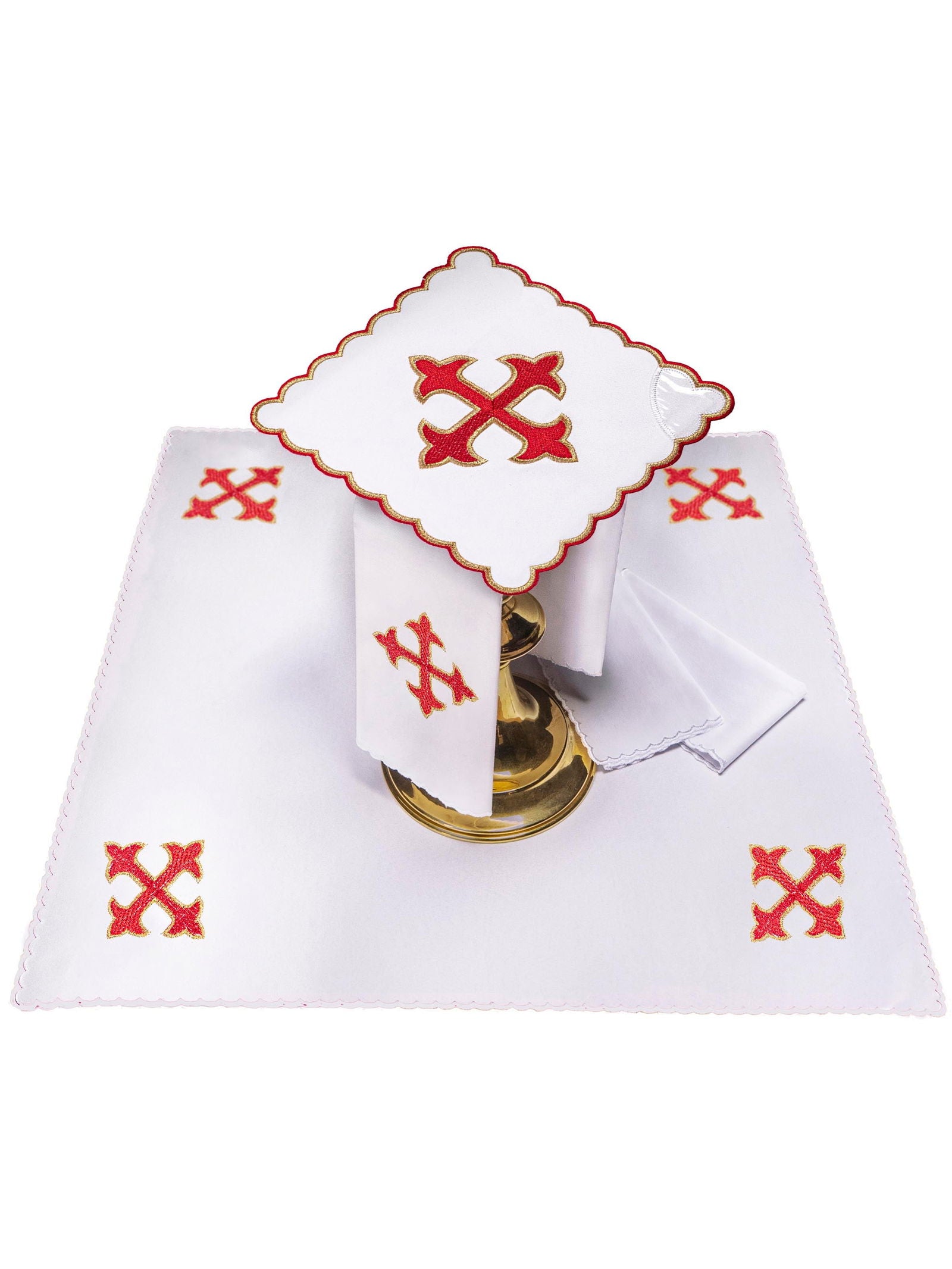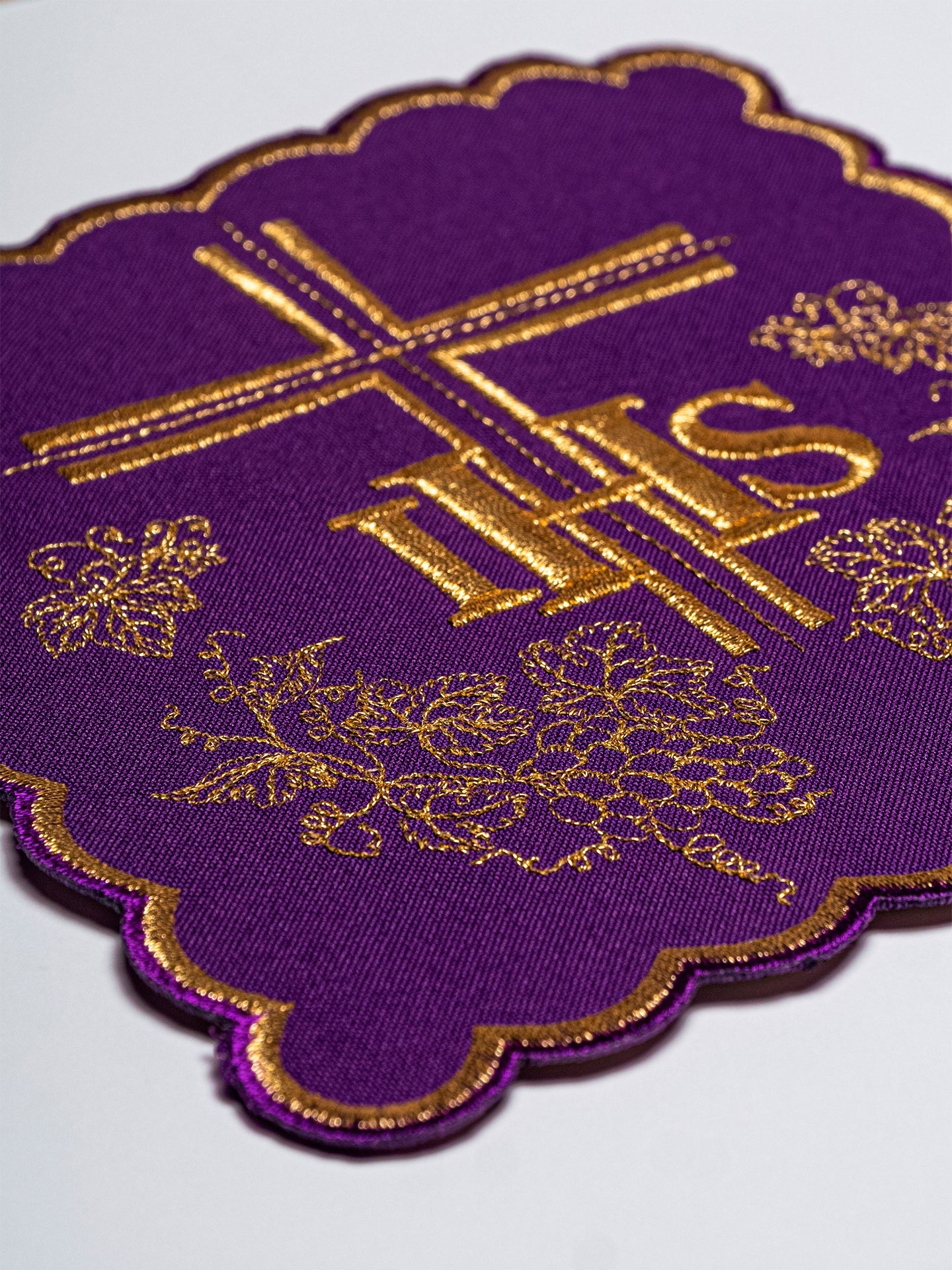Altar Cloths: Elevating Sacred Spaces with Exquisite Linens
The Significance of Altar Cloths in Liturgical Worship
Altar cloths, also known as altar linens or altar coverings, are essential elements in creating a reverent and beautiful atmosphere for worship services. These cloths serve not only a practical purpose, protecting the altar from spills and wear, but also a symbolic one, representing the purity, holiness, and sacredness of the altar as the focal point of the church. The selection of appropriate church altar cloths enhances the overall worship experience, adding to the solemnity and beauty of the service.
Throughout Christian history, the use of altar cloths has been a tradition, evolving in design and materials but always maintaining its core purpose of honoring God and providing a fitting setting for the Eucharist. From simple, unadorned linens to richly embroidered and ornamented fabrics, altar cloths reflect the liturgical season, the specific occasion, and the traditions of the particular denomination.
Exploring the Variety of Altar Cloths: Materials, Designs, and Sizes
When selecting altar cloths, several factors come into play. The material, design, size, and color should all be carefully considered to ensure the cloth is appropriate for the altar and the liturgical setting. Here's a closer look at the options available:
Altar Cloth Materials: From Linen to Synthetics
Traditionally, altar cloths are made from natural fibers, with linen being the most common and highly regarded choice. Linen is durable, absorbent, and has a beautiful drape. It also symbolizes purity and cleanliness, making it a fitting material for use in sacred spaces. Other natural fiber options include cotton and hemp, each offering its own unique characteristics. For practicality and durability, some altar cloths incorporate synthetic fibers or blends, which can be easier to care for and less prone to wrinkling. However, when considering synthetic materials, it's essential to prioritize quality and ensure the fabric is appropriate for a worship environment.
Altar Cloth Designs: Embroidered, Plain, and Custom Options
The design of an altar cloth can range from simple and unadorned to elaborately embroidered and ornamented. Plain white altar cloths are often used for general worship services, while embroidered cloths may feature Christian symbols, such as crosses, grapes, wheat, or other liturgical motifs. The choice of design often depends on the liturgical season or the specific occasion. For example, a richly embroidered altar cloth with gold accents might be used for Easter or Christmas, while a simpler cloth in a somber color might be used during Lent or Advent. Custom altar cloths offer the opportunity to create a unique and personalized design that reflects the specific traditions and aesthetics of a particular church or congregation. Customization can include embroidery, appliqué, or other decorative techniques.
Altar Cloth Sizes: Ensuring a Proper Fit for Your Altar
Altar cloths are available in a variety of sizes to accommodate different altar dimensions. It's essential to measure the altar accurately before selecting a cloth to ensure a proper fit. The cloth should drape gracefully over the edges of the altar, creating a visually appealing and reverent appearance. Some altar cloths are designed to cover the entire altar, while others are intended to be used as altar frontals, which hang down from the front of the altar. The appropriate size and style of altar cloth will depend on the specific design of the altar and the preferences of the church or congregation.
Types of Altar Cloths and Their Specific Uses
The term altar cloth encompasses several different types of linens used on or around the altar. Each has a specific purpose and contributes to the overall presentation of the sacred space.
Fair Linen: The Foundation of the Altar Setting
The fair linen is a white linen cloth that covers the entire top surface of the altar. It serves as the primary layer of protection and is usually the first cloth placed on the altar. Its pure white color symbolizes the purity of Christ and the sanctity of the altar. The fair linen is typically made of high-quality linen and is carefully laundered and ironed to maintain its pristine appearance.
Altar Frontals: Adding Liturgical Color and Symbolism
Altar frontals are decorative panels that hang down from the front of the altar. They are often made of richly colored and embroidered fabrics and are changed according to the liturgical season. The colors of the altar frontal correspond to the liturgical calendar, with white being used for feasts, green for ordinary time, purple for Lent and Advent, and red for Pentecost and feasts of martyrs. Altar frontals add visual interest and symbolism to the altar, enhancing the worship experience and reminding worshippers of the specific season or occasion.
Altar Runners: A Decorative and Practical Addition
Altar runners are long, narrow cloths that run lengthwise across the top of the altar. They can be used in addition to or in place of a full altar cloth. Altar runners are often decorated with embroidery or other embellishments and can be changed to reflect the liturgical season or the specific occasion. They provide a decorative touch while also protecting the altar surface from spills and wear.
Selecting the Right Altar Cloth for Your Church: Key Considerations
Choosing the right altar cloth involves considering several factors to ensure it complements the church's aesthetics, liturgical practices, and budget. Here are some key considerations:
Liturgical Season and Color
The liturgical season is a primary factor in selecting the appropriate altar cloth. As mentioned earlier, different colors are associated with different seasons, and the altar cloth should reflect the current liturgical color. Having a set of altar cloths in various colors allows the church to properly observe the liturgical calendar and enhance the worship experience.
Church's Style and Aesthetics
The style and aesthetics of the church building should also be taken into account when selecting altar cloths. A traditional church might opt for classic designs and rich fabrics, while a more modern church might prefer simpler designs and contemporary materials. The altar cloth should complement the overall design of the church and create a harmonious and visually appealing worship space.
Budget and Durability
The budget is always a consideration when purchasing altar cloths. High-quality linen cloths can be expensive, but they are also durable and long-lasting. Synthetic or blended fabrics may be more affordable, but they may not have the same aesthetic appeal or durability as natural fibers. It's essential to strike a balance between cost and quality, choosing a cloth that is both affordable and appropriate for the church's needs. Consider the long-term cost of cleaning and maintenance when making your decision.
Caring for Your Altar Cloths: Ensuring Longevity and Beauty
Proper care is essential to maintaining the beauty and longevity of your altar cloths. Here are some tips for caring for different types of altar cloths:
Linen Altar Cloths: Gentle Washing and Ironing
Linen altar cloths should be washed gently in cool water with a mild detergent. Avoid using bleach or harsh chemicals, as these can damage the fibers. Linen can be machine-washed on a delicate cycle, but hand-washing is often recommended for older or more delicate cloths. After washing, linen cloths should be ironed while still slightly damp to prevent wrinkles. Use a hot iron and a pressing cloth to protect the fabric from scorching.
Embroidered Altar Cloths: Special Care and Attention
Embroidered altar cloths require special care to protect the delicate embroidery. Hand-washing is always the safest option for embroidered cloths. Use cool water and a mild detergent, and gently agitate the cloth to remove dirt and stains. Avoid rubbing or scrubbing the embroidery, as this can damage the threads. After washing, gently blot the cloth with a towel to remove excess water and allow it to air dry. Iron the cloth on the reverse side, using a pressing cloth to protect the embroidery.
Synthetic Altar Cloths: Easy Care and Maintenance
Synthetic altar cloths are generally easier to care for than natural fiber cloths. They can usually be machine-washed and dried on a low setting. However, it's essential to follow the manufacturer's instructions to avoid damaging the fabric. Avoid using high heat, as this can melt or shrink synthetic fibers. Synthetic cloths are generally wrinkle-resistant, but they can be ironed on a low setting if necessary.
Where to Buy Altar Cloths: Finding the Perfect Linens for Your Church
Altar cloths can be purchased from a variety of sources, including:
Religious Supply Stores: A Wide Selection of Options
Religious supply stores offer a wide selection of altar cloths in various materials, designs, and sizes. These stores often specialize in liturgical items and can provide expert advice on selecting the right cloth for your church. They may also offer custom design services.
Online Retailers: Convenience and Variety
Online retailers offer a convenient way to shop for altar cloths from the comfort of your own home. Many online retailers offer a wide selection of options and competitive prices. However, it's essential to choose a reputable retailer and to carefully review the product descriptions and images before making a purchase.
Custom Altar Cloth Makers: Personalized Designs and Craftsmanship
For a truly unique and personalized altar cloth, consider working with a custom altar cloth maker. These artisans can create a cloth to your exact specifications, incorporating your church's logo, colors, and design elements. Custom altar cloths are often more expensive than mass-produced cloths, but they offer a level of quality and craftsmanship that is unmatched.
Investing in Quality Altar Cloths: A Reflection of Reverence and Beauty
Altar cloths are more than just decorative items they are essential elements in creating a reverent and beautiful worship space. By carefully selecting and caring for your altar cloths, you can enhance the worship experience and honor God. Whether you choose simple white linens or richly embroidered fabrics, investing in quality altar cloths is an investment in the spiritual life of your church. Consider the materials, designs, sizes, and care requirements when making your selection, and choose cloths that reflect the traditions, aesthetics, and liturgical practices of your congregation. The right altar cloths will not only protect and beautify your altar but also contribute to a more meaningful and uplifting worship experience for all.
The Importance of Altar Linens in Special Occasions
Altar linens play a significant role during special occasions such as weddings, funerals, and baptisms. The altar cloths used during these events often feature unique designs or colors to reflect the solemnity and joy of the occasion. For example, a wedding might feature an altar cloth with delicate floral embroidery, while a funeral might utilize a simple, unadorned cloth in a somber color.
The Role of Altar Cloths in Different Denominations
The use and style of altar cloths can vary among different Christian denominations. Catholic churches often use more elaborate altar cloths with intricate embroidery and multiple layers, while Protestant churches may prefer simpler designs. Understanding the specific traditions and preferences of your denomination is crucial when selecting altar cloths.
Altar Cloths as a Symbol of Unity
Altar cloths can also serve as a symbol of unity within a congregation. Churches may choose to create or purchase altar cloths that reflect the diverse backgrounds and cultures of their members. These cloths can incorporate designs or symbols that are meaningful to different groups within the church, fostering a sense of belonging and shared identity.
The Evolution of Altar Cloth Designs
Altar cloth designs have evolved over time, reflecting changes in artistic styles, liturgical practices, and cultural influences. In the past, altar cloths were often made by hand using traditional techniques such as embroidery and weaving. Today, modern technology allows for the creation of more intricate and detailed designs, but the craftsmanship and artistry of handmade altar cloths remain highly valued.
The Connection Between Altar Cloths and Sacred Art
Altar cloths are often considered a form of sacred art, reflecting the beauty and holiness of God. The designs and symbols featured on altar cloths can inspire and uplift worshippers, reminding them of the divine presence in their midst. Churches may choose to display their altar cloths as part of their overall art collection, showcasing the craftsmanship and artistry of these sacred textiles.
The Impact of Altar Cloths on the Worship Environment
Altar cloths have a significant impact on the overall worship environment, creating a sense of reverence, beauty, and order. The careful selection and placement of altar cloths can transform a simple space into a sacred sanctuary, inviting worshippers to connect with God in a more meaningful way. Churches may invest in high-quality altar cloths as a way to enhance the spiritual experience of their members.
Conclusion: Choosing the Right Altar Cloths for a Meaningful Worship Experience
In conclusion, altar cloths are an integral part of creating a meaningful and reverent worship experience. From understanding the significance of altar linens in liturgical worship to exploring the variety of materials, designs, and sizes available, selecting the right altar cloths requires careful consideration. By focusing on the liturgical season, church aesthetics, budget, and the importance of proper care, churches can invest in quality altar cloths that reflect reverence and beauty. Whether purchasing from religious supply stores, online retailers, or custom altar cloth makers, the perfect linens can elevate sacred spaces and enhance the spiritual journey of the congregation.
``````csv
Altar Cloths: Elevating Sacred Spaces with Exquisite Linens
The Significance of Altar Cloths in Liturgical Worship
Altar cloths, also known as altar linens or altar coverings, are essential elements in creating a reverent and beautiful atmosphere for worship services. These cloths serve not only a practical purpose, protecting the altar from spills and wear, but also a symbolic one, representing the purity, holiness, and sacredness of the altar as the focal point of the church. The selection of appropriate church altar cloths enhances the overall worship experience, adding to the solemnity and beauty of the service.
Throughout Christian history, the use of altar cloths has been a tradition, evolving in design and materials but always maintaining its core purpose of honoring God and providing a fitting setting for the Eucharist. From simple, unadorned linens to richly embroidered and ornamented fabrics, altar cloths reflect the liturgical season, the specific occasion, and the traditions of the particular denomination.
Exploring the Variety of Altar Cloths: Materials, Designs, and Sizes
When selecting altar cloths, several factors come into play. The material, design, size, and color should all be carefully considered to ensure the cloth is appropriate for the altar and the liturgical setting. Here's a closer look at the options available:
Altar Cloth Materials: From Linen to Synthetics
Traditionally, altar cloths are made from natural fibers, with linen being the most common and highly regarded choice. Linen is durable, absorbent, and has a beautiful drape. It also symbolizes purity and cleanliness, making it a fitting material for use in sacred spaces. Other natural fiber options include cotton and hemp, each offering its own unique characteristics. For practicality and durability, some altar cloths incorporate synthetic fibers or blends, which can be easier to care for and less prone to wrinkling. However, when considering synthetic materials, it's essential to prioritize quality and ensure the fabric is appropriate for a worship environment.
Altar Cloth Designs: Embroidered, Plain, and Custom Options
The design of an altar cloth can range from simple and unadorned to elaborately embroidered and ornamented. Plain white altar cloths are often used for general worship services, while embroidered cloths may feature Christian symbols, such as crosses, grapes, wheat, or other liturgical motifs. The choice of design often depends on the liturgical season or the specific occasion. For example, a richly embroidered altar cloth with gold accents might be used for Easter or Christmas, while a simpler cloth in a somber color might be used during Lent or Advent. Custom altar cloths offer the opportunity to create a unique and personalized design that reflects the specific traditions and aesthetics of a particular church or congregation. Customization can include embroidery, appliqué, or other decorative techniques.
Altar Cloth Sizes: Ensuring a Proper Fit for Your Altar
Altar cloths are available in a variety of sizes to accommodate different altar dimensions. It's essential to measure the altar accurately before selecting a cloth to ensure a proper fit. The cloth should drape gracefully over the edges of the altar, creating a visually appealing and reverent appearance. Some altar cloths are designed to cover the entire altar, while others are intended to be used as altar frontals, which hang down from the front of the altar. The appropriate size and style of altar cloth will depend on the specific design of the altar and the preferences of the church or congregation.
Types of Altar Cloths and Their Specific Uses
The term altar cloth encompasses several different types of linens used on or around the altar. Each has a specific purpose and contributes to the overall presentation of the sacred space.
Fair Linen: The Foundation of the Altar Setting
The fair linen is a white linen cloth that covers the entire top surface of the altar. It serves as the primary layer of protection and is usually the first cloth placed on the altar. Its pure white color symbolizes the purity of Christ and the sanctity of the altar. The fair linen is typically made of high-quality linen and is carefully laundered and ironed to maintain its pristine appearance.
Altar Frontals: Adding Liturgical Color and Symbolism
Altar frontals are decorative panels that hang down from the front of the altar. They are often made of richly colored and embroidered fabrics and are changed according to the liturgical season. The colors of the altar frontal correspond to the liturgical calendar, with white being used for feasts, green for ordinary time, purple for Lent and Advent, and red for Pentecost and feasts of martyrs. Altar frontals add visual interest and symbolism to the altar, enhancing the worship experience and reminding worshippers of the specific season or occasion.
Altar Runners: A Decorative and Practical Addition
Altar runners are long, narrow cloths that run lengthwise across the top of the altar. They can be used in addition to or in place of a full altar cloth. Altar runners are often decorated with embroidery or other embellishments and can be changed to reflect the liturgical season or the specific occasion. They provide a decorative touch while also protecting the altar surface from spills and wear.
Selecting the Right Altar Cloth for Your Church: Key Considerations
Choosing the right altar cloth involves considering several factors to ensure it complements the church's aesthetics, liturgical practices, and budget. Here are some key considerations:
Liturgical Season and Color
The liturgical season is a primary factor in selecting the appropriate altar cloth. As mentioned earlier, different colors are associated with different seasons, and the altar cloth should reflect the current liturgical color. Having a set of altar cloths in various colors allows the church to properly observe the liturgical calendar and enhance the worship experience.
Church's Style and Aesthetics
The style and aesthetics of the church building should also be taken into account when selecting altar cloths. A traditional church might opt for classic designs and rich fabrics, while a more modern church might prefer simpler designs and contemporary materials. The altar cloth should complement the overall design of the church and create a harmonious and visually appealing worship space.
Budget and Durability
The budget is always a consideration when purchasing altar cloths. High-quality linen cloths can be expensive, but they are also durable and long-lasting. Synthetic or blended fabrics may be more affordable, but they may not have the same aesthetic appeal or durability as natural fibers. It's essential to strike a balance between cost and quality, choosing a cloth that is both affordable and appropriate for the church's needs. Consider the long-term cost of cleaning and maintenance when making your decision.
Caring for Your Altar Cloths: Ensuring Longevity and Beauty
Proper care is essential to maintaining the beauty and longevity of your altar cloths. Here are some tips for caring for different types of altar cloths:
Linen Altar Cloths: Gentle Washing and Ironing
Linen altar cloths should be washed gently in cool water with a mild detergent. Avoid using bleach or harsh chemicals, as these can damage the fibers. Linen can be machine-washed on a delicate cycle, but hand-washing is often recommended for older or more delicate cloths. After washing, linen cloths should be ironed while still slightly damp to prevent wrinkles. Use a hot iron and a pressing cloth to protect the fabric from scorching.
Embroidered Altar Cloths: Special Care and Attention
Embroidered altar cloths require special care to protect the delicate embroidery. Hand-washing is always the safest option for embroidered cloths. Use cool water and a mild detergent, and gently agitate the cloth to remove dirt and stains. Avoid rubbing or scrubbing the embroidery, as this can damage the threads. After washing, gently blot the cloth with a towel to remove excess water and allow it to air dry. Iron the cloth on the reverse side, using a pressing cloth to protect the embroidery.
Synthetic Altar Cloths: Easy Care and Maintenance
Synthetic altar cloths are generally easier to care for than natural fiber cloths. They can usually be machine-washed and dried on a low setting. However, it's essential to follow the manufacturer's instructions to avoid damaging the fabric. Avoid using high heat, as this can melt or shrink synthetic fibers. Synthetic cloths are generally wrinkle-resistant, but they can be ironed on a low setting if necessary.
Where to Buy Altar Cloths: Finding the Perfect Linens for Your Church
Altar cloths can be purchased from a variety of sources, including:
Religious Supply Stores: A Wide Selection of Options
Religious supply stores offer a wide selection of altar cloths in various materials, designs, and sizes. These stores often specialize in liturgical items and can provide expert advice on selecting the right cloth for your church. They may also offer custom design services.
Online Retailers: Convenience and Variety
Online retailers offer a convenient way to shop for altar cloths from the comfort of your own home. Many online retailers offer a wide selection of options and competitive prices. However, it's essential to choose a reputable retailer and to carefully review the product descriptions and images before making a purchase.
Custom Altar Cloth Makers: Personalized Designs and Craftsmanship
For a truly unique and personalized altar cloth, consider working with a custom altar cloth maker. These artisans can create a cloth to your exact specifications, incorporating your church's logo, colors, and design elements. Custom altar cloths are often more expensive than mass-produced cloths, but they offer a level of quality and craftsmanship that is unmatched.
Investing in Quality Altar Cloths: A Reflection of Reverence and Beauty
Altar cloths are more than just decorative items they are essential elements in creating a reverent and beautiful worship space. By carefully selecting and caring for your altar cloths, you can enhance the worship experience and honor God. Whether you choose simple white linens or richly embroidered fabrics, investing in quality altar cloths is an investment in the spiritual life of your church. Consider the materials, designs, sizes, and care requirements when making your selection, and choose cloths that reflect the traditions, aesthetics, and liturgical practices of your congregation. The right altar cloths will not only protect and beautify your altar but also contribute to a more meaningful and uplifting worship experience for all.
The Importance of Altar Linens in Special Occasions
Altar linens play a significant role during special occasions such as weddings, funerals, and baptisms. The altar cloths used during these events often feature unique designs or colors to reflect the solemnity and joy of the occasion. For example, a wedding might feature an altar cloth with delicate floral embroidery, while a funeral might utilize a simple, unadorned cloth in a somber color.
The Role of Altar Cloths in Different Denominations
The use and style of altar cloths can vary among different Christian denominations. Catholic churches often use more elaborate altar cloths with intricate embroidery and multiple layers, while Protestant churches may prefer simpler designs. Understanding the specific traditions and preferences of your denomination is crucial when selecting altar cloths.
Altar Cloths as a Symbol of Unity
Altar cloths can also serve as a symbol of unity within a congregation. Churches may choose to create or purchase altar cloths that reflect the diverse backgrounds and cultures of their members. These cloths can incorporate designs or symbols that are meaningful to different groups within the church, fostering a sense of belonging and shared identity.
The Evolution of Altar Cloth Designs
Altar cloth designs have evolved over time, reflecting changes in artistic styles, liturgical practices, and cultural influences. In the past, altar cloths were often made by hand using traditional techniques such as embroidery and weaving. Today, modern technology allows for the creation of more intricate and detailed designs, but the craftsmanship and artistry of handmade altar cloths remain highly valued.
The Connection Between Altar Cloths and Sacred Art
Altar cloths are often considered a form of sacred art, reflecting the beauty and holiness of God. The designs and symbols featured on altar cloths can inspire and uplift worshippers, reminding them of the divine presence in their midst. Churches may choose to display their altar cloths as part of their overall art collection, showcasing the craftsmanship and artistry of these sacred textiles.
The Impact of Altar Cloths on the Worship Environment
Altar cloths have a significant impact on the overall worship environment, creating a sense of reverence, beauty, and order. The careful selection and placement of altar cloths can transform a simple space into a sacred sanctuary, inviting worshippers to connect with God in a more meaningful way. Churches may invest in high-quality altar cloths as a way to enhance the spiritual experience of their members.
Conclusion: Choosing the Right Altar Cloths for a Meaningful Worship Experience
In conclusion, altar cloths are an integral part of creating a meaningful and reverent worship experience. From understanding the significance of altar linens in liturgical worship to exploring the variety of materials, designs, and sizes available, selecting the right altar cloths requires careful consideration. By focusing on the liturgical season, church aesthetics, budget, and the importance of proper care, churches can invest in quality altar cloths that reflect reverence and beauty. Whether purchasing from religious supply stores, online retailers, or custom altar cloth makers, the perfect linens can elevate sacred spaces and enhance the spiritual journey of the congregation.




























